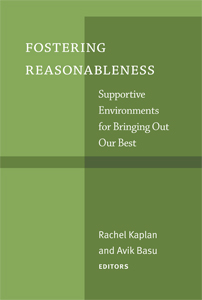
Fostering Reasonableness: Supportive Environments for Bringing Out Our Best
Skip other details (including permanent urls, DOI, citation information): This work is licensed under a Creative Commons Attribution-NonCommercial-NoDerivatives 3.0 License. Please contact mpub-help@umich.edu to use this work in a way not covered by the license.
For more information, read Michigan Publishing's access and usage policy.
Part VI. Small Steps, Big Differences
Road Map to Part VI
Many themes, contexts, opportunities, and challenges that we all face daily cut across the chapters of this book. One of these—engagement—has been a central theme in many of the chapters. For example, the chapters in the previous section, “Engaged Learning,” all speak to ways to support, encourage, and promote engagement. Wells and Pillemer (“Participation in Environmental Stewardship” section) discuss ways that engagement enhances stewardship experiences, and Bardwell (“Leadership: Leveraging Talent” section) shows how important engagement can be for effective organizational functioning. Engagement is also the focus of the first chapter in this section. As the title of Jason Duvall’s chapter suggests, he looks at engagement as a widely applicable tool. Duvall’s research provides concrete examples of how activities that may be difficult to sustain can become more durable through the support offered by an engaging strategy.
Participation is another theme that cuts across many chapters, including Grese’s (“Engaged Learning” section), Gallagher’s (“Leadership: Leveraging Talent” section), and Monroe’s (“Finding Agreement” section). The second chapter in this section, by Kimberly Phalen, provides empirical support for some important benefits of participation and how to make the participatory process more effective. Phalen’s chapter also offers some tools that are applicable in other contexts. In this case, tools are for the assessment of the domains of the Reasonable Person Model (RPM). Her chapter is unique in testing some of RPM’s assumptions.
The final chapter explores these and other crosscutting themes, including expertise and limited capacity as well as trust and respect. Its emphasis, however, is on the overarching theme that runs throughout the volume. The notion of supportive environments is difficult to grasp yet pervasive in its reach. It often entails small steps that can make big differences.
Chapter 20: Jason Duvall, “Engagement as a Tool for Sustaining Change”
Jason Duvall’s discussion of engagement provides many concrete suggestions about strategies for increasing involvement while also giving a much fuller understanding of the complexities that come with the concept. Engagement is a powerful tool but is no panacea. Duvall describes several considerations that increase the likelihood of engagement leading to sustained outcomes. Indeed, though they vary in how explicitly they draw on it, many of the chapters in this volume relate to engagement, including those by Bardwell, Kumler, and Wells and Pillemer.
Chapter 21: Kimberly Bosworth Phalen, “Evidence—Based Approaches to Public Participation in Design Decisions”
RPM is central to Kimberly Phalen’s chapter in a number of ways. She conducted a series of studies that provide empirical tests of RPM in the context of public participation in design. Using the findings from the studies, Phalen then offers a rich set of recommendations framed in terms of RPM. Supportive environments are raised in two ways. First, the participatory process seeks public input so that places can be created that are more supportive of the public’s needs. Second, Phalen shows that the participatory process itself is an environment that can be designed to better support information sharing, engagement, and meaningful participation.
Chapter 22: Rachel Kaplan and Avik Basu, “Fostering Our Common Humanity”
RPM provides a framework that is widely applicable. It can be useful in daily tasks and decisions that we all face in our personal and communal lives, in how we relate to others whom we know or don’t know, and in our approach to bringing out the best in ourselves and humanity. It may be presumptuous to think that such a simple, portable framework can span this vast range of issues and situations. RPM does not provide a solution but does provide a way to think about these contexts. How can we foster reasonableness? How can we make situations more concordant with human values? How can we enhance communication and understanding? Drawing on all the chapters that preceded it, Rachel Kaplan and Avik Basu offer suggestions for small steps that build supportive environments that bring us closer to fostering our common humanity.


